戴炜栋《简明语言学教程》配套笔记_自己整理版
- 格式:pdf
- 大小:313.46 KB
- 文档页数:14
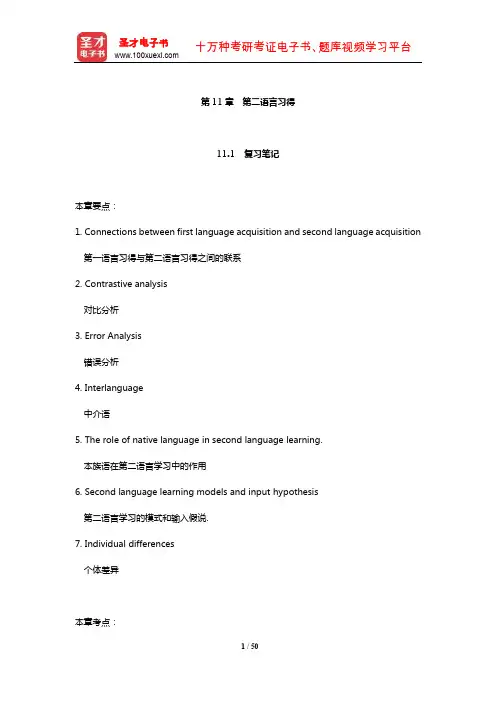
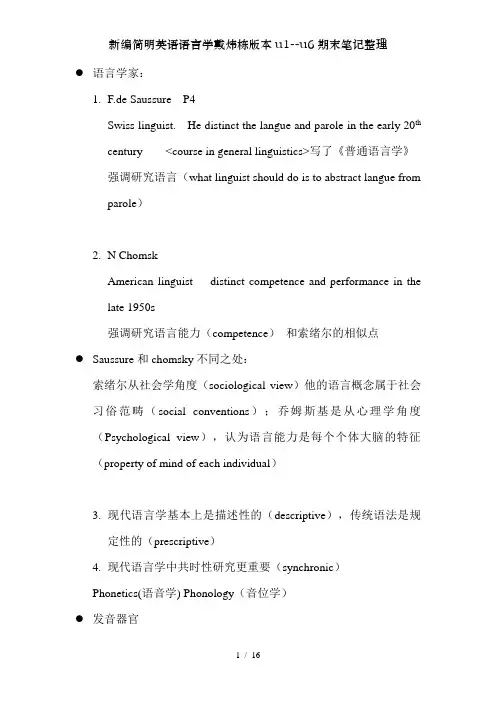
●语言学家:1.F.de Saussure P4Swiss linguist. He distinct the langue and parole in the early 20thcentury <course in general linguistics>写了《普通语言学》强调研究语言(what linguist should do is to abstract langue from parole)2.N ChomskAmerican linguist distinct competence and performance in the late 1950s强调研究语言能力(competence)和索绪尔的相似点●Saussure和chomsky不同之处:索绪尔从社会学角度(sociological view)他的语言概念属于社会习俗范畴(social conventions);乔姆斯基是从心理学角度(Psychological view),认为语言能力是每个个体大脑的特征(property of mind of each individual)3.现代语言学基本上是描述性的(descriptive),传统语法是规定性的(prescriptive)4.现代语言学中共时性研究更重要(synchronic)Phonetics(语音学) Phonology(音位学)●发音器官1.pharyngeal cavity2.oral cavity3.nasal cavity●speech and writing are the two media or substances 言语和文字是自然语言的两种媒介和物质(言语比文字更加基础)●语音学从哪三个角度研究?(1)说话者角度articulatory phonetics 发声语音学(历史最悠久)(2)听话者角度auditory phonetics 听觉语音学(3)研究语音的传播方式acoustic phonetics 声学语音学●主要现在用IPA标音标,但是语言学家会用严式标音(narrowtranscription)书上举了两个字母的例子{l} leap,feel ,health {p} pit,spit (送气,不送气)p h来表送气●语音的分类:元音(voiced sound)和辅音●voiceless●元音的分类:(1)根据舌头哪一个部位最高,分为front、central、back(2)嘴巴的张合度,分为闭元音、半闭元音、半开元音、开元音(3)不圆唇的(所有前和中元音+{a:} )和圆唇的(rounded)后元音●Segment 和syllable 前面数有几个元音辅音;后面数有几个元音●语音学和音位学的区别(1)语音学家关注{l} 的发音,清晰舌边音和模糊舌边音(2)音位学家关注{l}分布模式,即在什么位置发这个音如{l} 在元音后或辅音前,发模糊舌边音feel、quilt{l}放在元音前发清晰的舌边音leap注意:Phonology is concerned with the sound system of a particular language.(关注某种语言的语音系统)Linguistics is the scientific study of human languages in general.一、区分音素,音位,音位变体●音素:phone(1)在单词feel[fi:ł],leaf[li:f],tar[tha:],star[sta:]中,一共有7个音素,分别是[f],[i:],[ł],[l],[th].[t],[a:].(2)英语共有48个音素,其中元音20个,辅音28个。

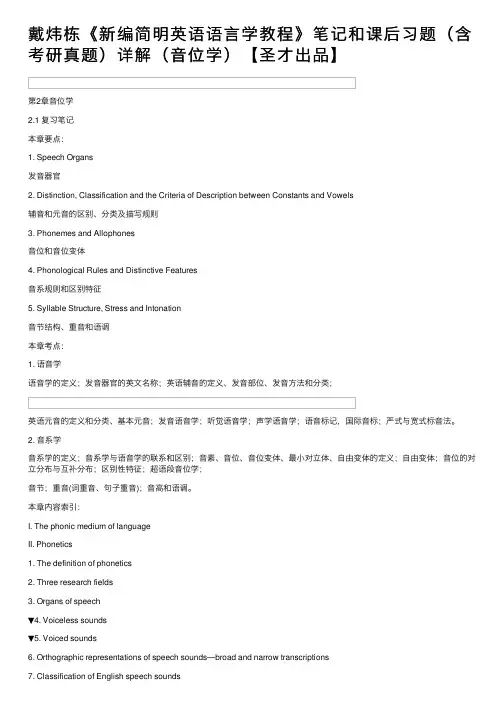
戴炜栋《新编简明英语语⾔学教程》笔记和课后习题(含考研真题)详解(⾳位学)【圣才出品】第2章⾳位学2.1 复习笔记本章要点:1. Speech Organs发⾳器官2. Distinction, Classification and the Criteria of Description between Constants and Vowels辅⾳和元⾳的区别、分类及描写规则3. Phonemes and Allophones⾳位和⾳位变体4. Phonological Rules and Distinctive Features⾳系规则和区别特征5. Syllable Structure, Stress and Intonation⾳节结构、重⾳和语调本章考点:1. 语⾳学语⾳学的定义;发⾳器官的英⽂名称;英语辅⾳的定义、发⾳部位、发⾳⽅法和分类;英语元⾳的定义和分类、基本元⾳;发⾳语⾳学;听觉语⾳学;声学语⾳学;语⾳标记,国际⾳标;严式与宽式标⾳法。
2. ⾳系学⾳系学的定义;⾳系学与语⾳学的联系和区别;⾳素、⾳位、⾳位变体、最⼩对⽴体、⾃由变体的定义;⾃由变体;⾳位的对⽴分布与互补分布;区别性特征;超语段⾳位学;⾳节;重⾳(词重⾳、句⼦重⾳);⾳⾼和语调。
本章内容索引:I. The phonic medium of languageII. Phonetics1. The definition of phonetics2. Three research fields3. Organs of speech▼4. Voiceless sounds▼5. Voiced sounds6. Orthographic representations of speech sounds—broad and narrow transcriptions7. Classification of English speech sounds(1) Definition(2) Classification of English consonants(3) Classification of English vowelsIII. Phonology1. Relationship between Phonology and phonetics2. Phone, phoneme3. Allophone4. Some rules in phonology(1) Sequential rules(2) Assimilation rule(3) Deletion rule5. Supra-segmental features—stress, tone, intonation(1) Stress(2) Tone(3) IntonationI. The phonic medium of language(语⾔的语⾳媒介)II. Phonetics(语⾳学)1. The definition of phonetics(语⾳学的定义)Phonetics is defined as the study of the phonic medium of language; it is concerned with all the sounds that occur in the world’s languages.语⾳学被定义为对语⾔的语⾳媒介的研究;它涉及所有出现在世界语⾔中的声⾳。
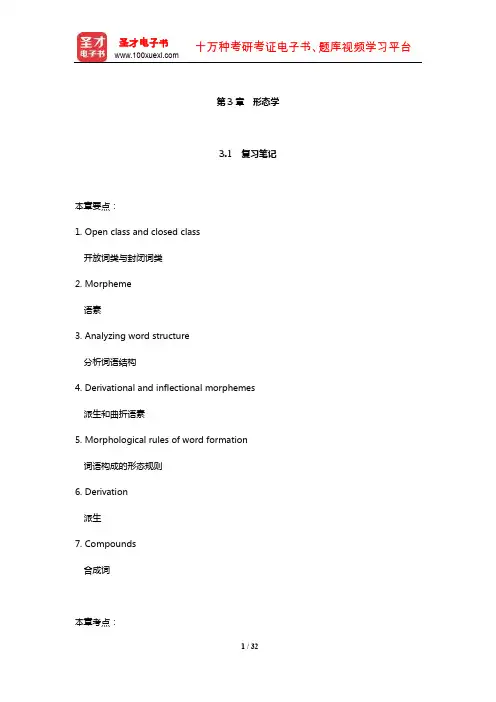
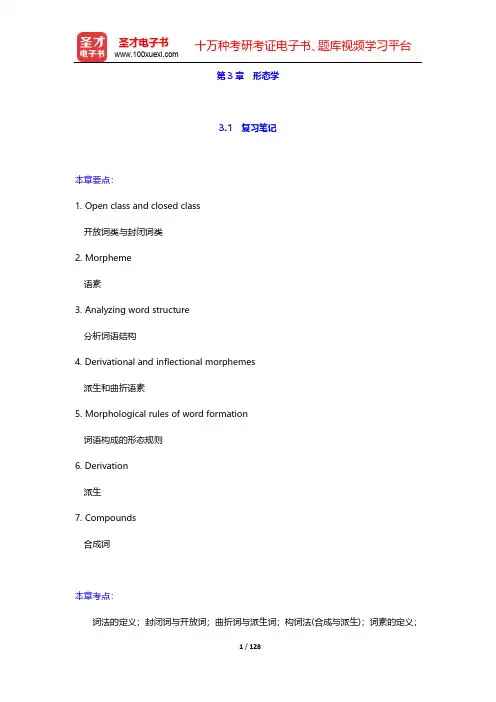
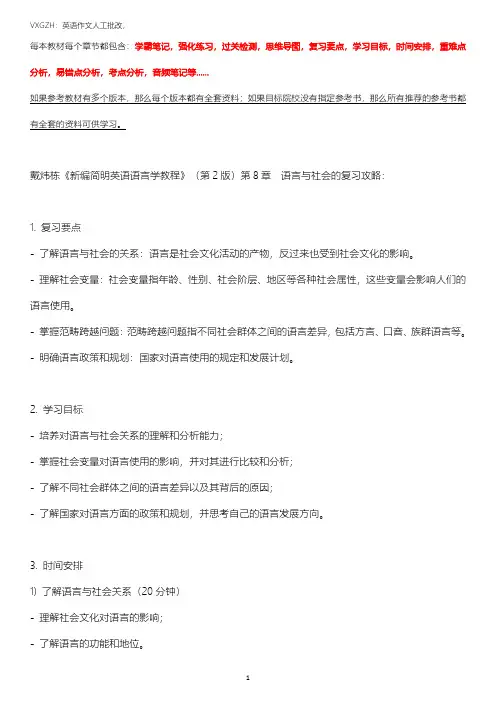
每本教材每个章节都包含:学霸笔记,强化练习,过关检测,思维导图,复习要点,学习目标,时间安排,重难点分析,易错点分析,考点分析,音频笔记等......如果参考教材有多个版本,那么每个版本都有全套资料;如果目标院校没有指定参考书,那么所有推荐的参考书都有全套的资料可供学习。
戴炜栋《新编简明英语语言学教程》(第2版)第8章语言与社会的复习攻略:1.复习要点-了解语言与社会的关系:语言是社会文化活动的产物,反过来也受到社会文化的影响。
-理解社会变量:社会变量指年龄、性别、社会阶层、地区等各种社会属性,这些变量会影响人们的语言使用。
-掌握范畴跨越问题:范畴跨越问题指不同社会群体之间的语言差异,包括方言、口音、族群语言等。
-明确语言政策和规划:国家对语言使用的规定和发展计划。
2.学习目标-培养对语言与社会关系的理解和分析能力;-掌握社会变量对语言使用的影响,并对其进行比较和分析;-了解不同社会群体之间的语言差异以及其背后的原因;-了解国家对语言方面的政策和规划,并思考自己的语言发展方向。
3.时间安排1)了解语言与社会关系(20分钟)-理解社会文化对语言的影响;-了解语言的功能和地位。
2)掌握社会变量(1小时)-掌握社会变量的概念;-分析社会变量对语言使用的影响;-通过实例加深对社会变量的理解。
3)范畴跨越问题(1小时)-探究方言、口音和族群语言等;-比较不同社会群体之间的语言差异;-分析范畴跨越问题背后的原因。
4)语言政策和规划(40分钟)-了解国家对语言方面的政策和规划;-思考自己的语言发展方向。
5)复习总结(20分钟)-回顾重点内容;-总结学习收获。

戴炜栋《简明语言学教程》配套笔记-自己整理版————————————————————————————————作者:————————————————————————————————日期:Chapter 1 IntroductionWhat is linguistics? 什么是语言学[A] The definition of linguisticsLinguistics is generally defined as the scientific study of language (对语言进行的科学研究)Process of linguistic study:① Certain linguistic facts are observed, generalization are formed;② Hypotheses are formulated;③ Hypotheses are tested by further observations;④ A linguistic theory is constructed.[B] The scope of linguistics General linguistics普通语言学: the study of language as a whole从整体研究1.Phonetics: the general study of the characteristics of speech sounds (or the study of the phonic medium of language) (How speech sounds are produced and classified)2.Phonology: is essentially the description of the systems and patterns of speech sounds in a language.(How sounds form systems and function to convey meaning)3.Morphology: the study of the way in which morphemes are arranged to form words (how morphemes are combined to form words)4.Syntax: the study of those rules that govern the combination of words to form permissible sentences (how morphemes and words are combined to form sentences)5.Semantics: the study of meaning in abstraction6.Pragmatics: the study of meaning in context of useSociolinguistics: the study of language with reference to societyPsycholinguistics: the study of language with reference to the workings of the mindApplied linguistics: the application of linguistics principles and theories to language teaching and learning Anthropological linguistics, neurological linguistics; mathematical linguistics; mathematical linguistics; computational linguistics[C] Some important distinctions in linguistics① Prescriptive vs. Descriptive 规定性与描写性② Synchronic vs. Diachronic 共时性与历时性(现代英语多研究共时性)The description of a language at some point in time;The description of a language as it changes through time.③ Speech and writing 言语与文字Spoken language is primary, not the written④ Langue and parole 语言和言语Proposed by Swiss linguists F. de Sausse (sociological)Langue: refers to the abstract linguistic system shared by all the members of a speech community(指一个话语社团所有成员共有的语言系统)Parole: refers to the realization of langue in actual use(指语言在实际运用中的实现)⑤ Competence and performance 语言能力与语言运用Proposed by the American linguist N. Chomsky (psychological)Competence: the ideal user’s knowledge of the rules of his languag e.(理想的语言使用者关于语言规则方面的知识)Performance: the actual realization of this knowledge in linguistics communication.(这种知识在语言交流中的具体实现)What is language? 什么是语言[A] The definition of languageLanguage is a system of arbitrary vocal symbols used for human communication. (语言是一个具有任意性、用于人类交流的语音符号系统。
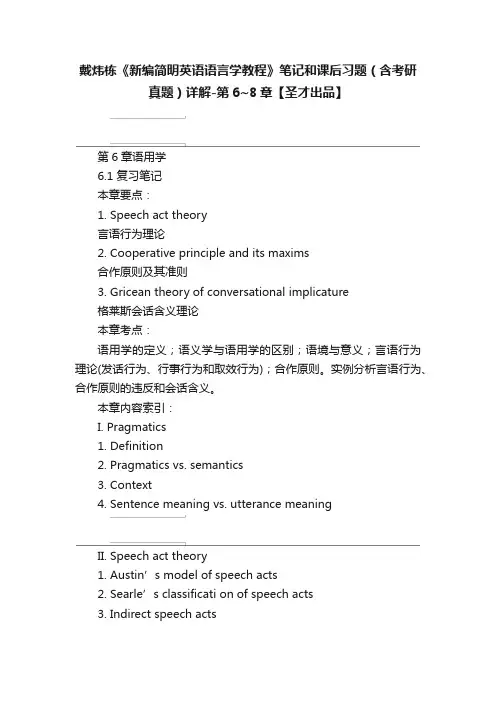
戴炜栋《新编简明英语语言学教程》笔记和课后习题(含考研真题)详解-第6~8章【圣才出品】第6章语用学6.1 复习笔记本章要点:1. Speech act theory言语行为理论2. Cooperative principle and its maxims合作原则及其准则3. Gricean theory of conversational implicature格莱斯会话含义理论本章考点:语用学的定义;语义学与语用学的区别;语境与意义;言语行为理论(发话行为、行事行为和取效行为);合作原则。
实例分析言语行为、合作原则的违反和会话含义。
本章内容索引:I. Pragmatics1. Definition2. Pragmatics vs. semantics3. Context4. Sentence meaning vs. utterance meaningII. Speech act theory1. Austin’s model of speech acts2. Searle’s classificati on of speech acts3. Indirect speech actsIII. Principle of conversation1. Cooperative Principle and its Maxims2. Violation of the MaximsIV. Conversational Implicature1. Definition2. Characteristics of Conversational Implicature(1) Calculability.(2) Cancellability(3) Non-detachability(4) Non-conventionality.V. Cross-cultural Pragmatic FailureI. Pragmatics(语用学)【考点:名词解释,与语义学的关系】1. Definition(定义)It is the study of how speakers of a language use sentences to effect successful communication.它是研究某一语言的言者是如何利用句子成功进行交际的。
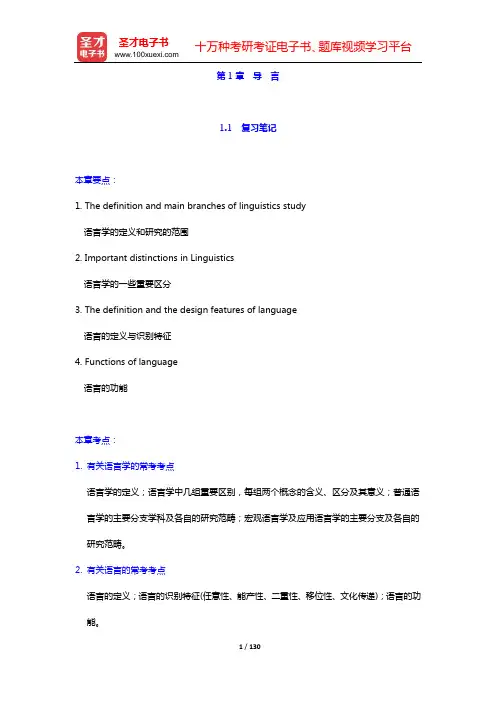
第1章导言1.1 复习笔记本章要点:1. The definition and main branches of linguistics study语言学的定义和研究的范围2. Important distinctions in Linguistics语言学的一些重要区分3. The definition and the design features of language语言的定义与识别特征4. Functions of language语言的功能本章考点:1. 有关语言学的常考考点语言学的定义;语言学中几组重要区别,每组两个概念的含义、区分及其意义;普通语言学的主要分支学科及各自的研究范畴;宏观语言学及应用语言学的主要分支及各自的研究范畴。
2. 有关语言的常考考点语言的定义;语言的识别特征(任意性、能产性、二重性、移位性、文化传递);语言的功能。
本章内容索引:I. The definition of linguisticsII. The scope of linguistics1. Micro-linguistics2. Macro-linguisticsIII. Some important distinctions in linguistics1. Descriptive vs. Prescriptive2. Synchronic vs. Diachronic3. Speech vs. Writing4. Langue vs. Parole5. Competence vs. Performance6. Traditional Grammar vs. Modern Linguistics IV. The definition of languageV. The design features of language1. Arbitrariness2. Productivity3. Duality4. Displacement5. Cultural Transmission6. InterchangeabilityVI. Functions of language1. Main functions2. Basic functions3. MacrofuntionsI. The definition of linguistics(语言学的定义)Linguistics is generally defined as the scientific study of language.It is a scientific study because it is based on the systematic investigation of linguistic data, conducted with reference to some general theory of language structure.语言学通常被定义为对语言进行科学性研究的学科。
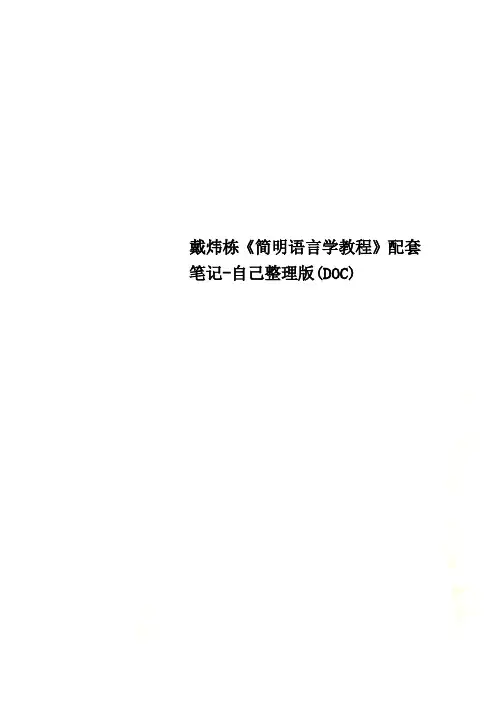
戴炜栋《简明语言学教程》配套笔记-自己整理版(DOC)[A] The definition of phonetics(语音学)Phonetics: the study of the phonic medium of language: it is concerned with all the sounds that occur in the wor ld’s languages.(是指对语言的语音媒介进行的研究,它关注语言世界中的所有语音)Articulatory phonetics: the study of how speech sounds are made, or articulated.(发音语音学)Acoustic phonetics: deals with the physical properties of speech as sound waves in the air.(听觉语音学)Auditory (or perceptual) phonetics: deals with the perception, via the ear, of speech sounds.(声学语音[B] Organs of speech (发音器官)清音when the vocal cords are spread apart, the air from the lungs passes between them unimpeded.Voiced (Voicing): 浊音when the vocal cords声带are drawn together, the air from the lungs repeated pushes them apart as it passes through, creating a vibration effect.All the English vowels元音are typically voiced (voicing).The important cavities:The pharyngeal cavity 咽腔The oral cavity 口腔The nasal cavity 鼻腔Lips唇1, teeth齿2, teeth ridge (alveolus)齿龈3, hard palate硬腭4, soft palate (velum)小舌6, tip of tongue舌尖7, blade of tongue舌面8, back of tongue舌后9, vocal cords[C] Orthographic representation of speech sounds:Broad and narrow transcriptions(语音的正字法表征:宽式/窄式标音)IPA (International Phonetic Alphabet/Association国际语音协会/国际音标)Broad transcription: the transcription with letter-symbols only (代表字母的符号)Narrow transcription: the transcription with letter-symbols together with the diacritics (变音符)E.g.:→[li:f]--→ a clear [l] (no diacritic)→[bild]--→a dark [l] (~)→[help]--→a dental [l] ( )[spit]--→an unaspirated [p] (no diacritic)[b tn]→a syllabic nasal [n] ()[D] Classification of English consonants(英语辅音的分类)In terms of manner of articulation 根据发音方法分闭塞音: the obstruction is total or complete, and then going abruptly[p]/[b], [t]/[d], [k]/[g]摩擦音: the obstruction is partial, and the air is forced through a narrow passage in the齿音: the tip of the tongue and the upper front teeth [θ]/[δ]齿龈音: the front part of the tongue on the alveolar ridge [t]/[d], [s]/[z], [n], [l], [r]腭音: tongue in the middle of the palate [θ]/[δ], [t∫]/[dз], [j]软腭因: the back of the tongue against the velum [k], [g], [η]喉音: the glottal is the space between the vocal cords in the larynx [h][E] Classification of English vowels (英语元音的分类)The highest position of the tongue: front, central, back;The openness of the mouth: close, semi-close, semi-open, open;The roundness (shape) of the month (the lips):All the front, central vowels are unrounded vowels except []All the back vowels, except [A:] are rounded vowelsThe length of the sound: long vowels & short vowelsLarynx → (tense) or (lax)Monophthongs, diphthongsCardinal vowelsMinimal pair: when two different forms are identical in every way except for one sound segment which occurs in the same place in the strings, the two sounds are said to form a minimal pair.When a group of words can be differentiated, each one from the others, by changing one phoneme (always in the same position), then all of these words constitute a minimal sets.[I] Some rules in phonologysequential rules 序列规则Phonotactics of 3 consonants occurring in onset: 如果三个辅音都出现在词首,必须遵循以下三条规则:第一个音位一定是/s/___voiceless stops: /p/, /t/, /k/ 第二个音位一定是/p/, /t/, /k/___approximants: /r/, /l/, /w/, /j/ 第三个音位一定是/r/, /l/, /w/, /j/The affricates [t∫],[dз] and the sibilants [s],[z],[θ],[δ] are not to be followed by another sibilants.assimilation rules 同化规则Co-articulation effects: the process of making one sound almost at the same time as the next is called co-articulation.Assimilation & elision effects 元音省略Assimilation: two phonemes occur in sequence and some aspect of one phoneme is taken or copied by the otherE.g. nasalize a vowel when it is followed by a nasal sound.鼻音化现象deletion rule/Elision 省略规则Definition: the omission of a sound segment which would be present in deliberate pronunciation of a word in isolationE.g. delete a [g] when it occurs before a final nasal consonant 省略词末鼻辅音前的[g]音[J] Suprasegmental features (超音段特征)Free morphemes: can stand by themselves as single wordsLexical morphemes [n.a.v] & functional morphemes [conj.prep.art.pron.]Bound morphemes: can not normally stand alone, but which are typically attached to another Derivational morphemes派生词素→affix词缀(suffix, infix, prefix) + root 后缀中缀Inflectional morphemes 曲折词素→ 8 types of inflectional morphemes in English-s [possessive所有格; plural复数]Verb + -s, -ing, -ed, -en [3rd person present singular第三人称单数; present participle现在分词过去式, past participle过去分词]Adj + -er, -est [comparative比较级; superlative最高级][C] Derivational vs. Inflectional 派生(范畴/语类)和曲折(语法标志)Inflectional morphemes never change the grammatical category of a word 只表示语法标志(时态、数、Inflectional morphemes influence the whole category词的范畴;Derivational morphemes are oppositeOrder: root (stem) + derivational + inflectional 词根/词干+派生+曲折[D] Morphological Rules 形态学规则(词的构成方式→词素是怎样组合成为词)N. +ly→ a.; A. +ly→ adv.; guard overgeneralization[E] Morphs and allomorphs 语素和语素变体: the actual forms used to realize morphemesAllomorphs: a set of morphs, all of which are versions of one morpheme,a morpheme may have alternate shapes or phonetic forms.map----maps [s][z]watch----watches [iz]Chapter 4 Syntax[A] The definition of syntaxSyntax: A branch of linguistics that studies how words are combined to form sentences and rules that govern the formation of sentences(句法学是研究词是如何组成句子以及如何支配句子构成规则的一个语言学分支)[C] Types of sentencesSimple sentence简单句: consists of a single clause which contains a subject and a predicate and stands alone as its own sentence.Coordinate (Compound) sentence并列(复合)句: contains two clauses joined by a linking word called coordinating conjunctions, such as “and”, “by”, “or”…Complex sentence复杂句: contains two, or more, clauses, one of which is incorporated into the Embedded clause子句←→ matrix clause主句subordinator ②functions as a grammatical unit ③ may be complete[B]Some categories(范畴)Syntactic categories: refer to a word or a phrase that performs a particular grammatical function, such as the subject or the predicate句法范畴Lexical categories: (parts of speech)词汇范畴Major lexical categories (open categories):N. V. Adj. Adv.Minor lexical categories (closed categories):Det. Aux. Prep. Pron. Conj. Int.Phrasal categories: NP, VP, PP, AP短语范畴[C]Combinational rulesAre small in number→ Yield all the possible sentencesRule out the impossible onesphrase structure rules (rewrite rules)(短语结构规则)Formal linguistic exploration:D-structure: phrase structure rules + lexiconSentence at the level of D-structureThe application of syntactic movement rules transforms a sentence fromD-structure level to S-structure levelTransformational-generative line of analysis[E]Syntactic RelationsSequential(syntagmatic) relations 组合关系The linear ordering of the words and the phrases within a sentenceSubstitutional(paradigmatic) relations (聚合关系)If the words or phrases in a sentence can be replaced by words and phrases outside the sentence and the resulting sentence is still grammatical, then we say the replacing forms and replaced forms have paradigmatic relations.[F] Immediate Constituent Analysis (IC Analysis)IC Analysis is to simply divide a sentence into its constituent elements without at first knowing what these elements are.The principle is that we take a sentence and cut it into two and then cut these parts into two and continue with this segmentation until we reach the smallest grammatical unit, the morphemesLabeled IC analysissyntactic categories criteria in judging syntactic categories:1) morphological features(inflectional and derivational affixes they take) (number,case gender etc.)2) syntactic contexts in which the linguistic forms can occurdeterminer (Det.)noun (n.)qualifierverb (v.)Det.degree word (Deg)phrasesare analyzed intowordsare analyzed into morphemessentencesphrasesare used to buildwordsare used to build morphemesSo traditionally, sentences are assumed to be made of individual words in a linear directionChapter 5 Semantics 语义学[A] The definition of semanticsSemantics: the study of meaning from the linguistic point of view (对意义的研究)[B] Some views concerning the study of meaning 关于意义研究的一些观点the naming theory命名论the conceptualist view概念论Thought/reference → concept 思想/指称Symbol/Form (words) 符号/形式Referent →(real object)所指contextualism: John Firth 语境论behaviorism → Bloomfield 行为主义论based on contextualist viewS: stimulus r: responseJill JackComplete homonyms: when two words are identical both in spelling and in Sound完全同音异义词 hyponymy下义关系—— inclusiveness 包含关系The word which is more general in meaning is called the superordinate.上坐标词The word which is more specific in meaning is called hyponym. Co-hyponym下坐标词 antonymy反义词——oppositenessGradable antonyms 等级反义词(有中间词,程度不同)Complementary antonyms互补反义词(两个极端dead/alive,male/female)Relational opposites: pairs of words that exhibit the reversal of a relationship between items(关系反义[E] Sense relations between sentences句子之间的意义关系X is synonymous with Y (X与Y同义)如果X真,Y真;X假,Y也假X is inconsistent with Y (X与Y不一致)如果X真,Y假;X假,Y真X entails Y (Y is an entailment of X) (X蕴含Y(Y是X的一个含义))X真,Y一定真(去过法国→一定去过欧洲)X假,Y有可能真(没去过法国→去/没去过欧洲欧洲)X presupposes Y (Y is a prerequisite of X) (X预设Y(Y是X的先决条件))X真,Y一定真X假,Y仍然真X is a contradiction X自我矛盾(总是假)X is semantically anomalous X语义反常[F] Componential analysis→a way to analyze lexical meaning (成分分析法→分析词汇意义的方法)Semantic features语义特征: the meaning of a word can be dissected into meaning components, or semantic featuresPhoneme→ distinctive features区别特征Show how those words are related in meaning[G] Predication analysis→a way to analyze sentence meaning proposed by British linguist G. Leech(述谓结构分析法→分析句子意义的方法)If it is, it is pragmatics.[B] Context 语境/上下文It is generally considered as constituted by the knowledge shared by the speaker and the(由说话人和听话人共有的知识构成)Sentence meaning and utterance meaning★句子意义和话语意义e.g. The dog is barking.If we take it as a grammatical unit and consider it as a self-contained unit in isolation, then we treat it as a sentence.如果把它当做一个语法单元,认为它是一个独立于语境之外的单元,那就当做句子If we take it as something a speaker utters in a certain situation with a certain purpose, then we are treating it as an utterance.如果把它当做是说话人在特定场景带着特定目的所说的话,那就当做话语Meaning of a sentence is abstract, and de-contextualized.句子的意义是抽象的,脱离语境的Meaning of an utterance is concrete, and contextualized.话语的意义是具体的,依赖语境的Utterance is based on sentence meaning; it is the realization of the abstract meaning of a sentence in a real situation of communication, or simply in a context.话语的意义基于句子的意义之上,它是句子的抽象意义在交际的真实场景中的体现[D] Speech Act Theory(言语行为理论)Direct speech actIndirect speech actFace-threateningFace-savingProposed by British philosopher John Austin in the late 1950sAnswer: what do we do when using language?叙事话语: statements that either state or describe, and thus verifiable陈述→可证实Performatives行事话语: sentences that don’t state a fact or describe a state, and are not verifiable (perform certain acts) 无法证实Gave the distinction between constatives and performatives and gave rise to a new model:。
戴炜栋《新编简明英语语言学教程》(第2版)笔记和课后习题(含考研真题)详解完整版>精研学习䋞>无偿试用20%资料
全国547所院校视频及题库全收集
考研全套>视频资料>课后答案>往年真题>职称考试
第1章导言
1.1复习笔记
1.2课后习题详解
1.3考研真题与典型题详解
第2章音位学
2.1复习笔记
2.2课后习题详解
2.3考研真题与典型题详解
第3章形态学
3.1复习笔记
3.2课后习题详解
3.3考研真题与典型题详解
第4章句法学
4.1复习笔记
4.2课后习题详解
4.3考研真题与典型题详解
第5章语义学
5.1复习笔记
5.2课后习题详解
5.3考研真题与典型题详解
第6章语用学
6.1复习笔记
6.2课后习题详解
6.3考研真题与典型题详解
第7章语言变化
7.1复习笔记
7.2课后习题详解
7.3考研真题与典型题详解
第8章语言与社会
8.1复习笔记
8.2课后习题详解
8.3考研真题与典型题详解
第9章语言与文化
9.1复习笔记
9.2课后习题详解
9.3考研真题与典型题详解第10章语言习得
10.1复习笔记
10.2课后习题详解
10.3考研真题与典型题详解第11章第二语言习得
11.1复习笔记
11.2课后习题详解
11.3考研真题与典型题详解第12章语言与大脑
12.1复习笔记
12.2课后习题详解
12.3考研真题与典型题详解。
每本教材每个章节都包含:学霸笔记,强化练习,过关检测,思维导图,复习要点,学习目标,时间安排,重难点分析,易错点分析,考点分析,音频笔记等......如果参考教材有多个版本,那么每个版本都有全套资料;如果目标院校没有指定参考书,那么所有推荐的参考书都有全套的资料可供学习。
戴炜栋《新编简明英语语言学教程》(第2版)这本书的第7章语言变化的复习攻略。
一、复习要点1.语言变化的定义:语言系统任意时刻内的某些方面或整体性质随时间而发生的改变。
2.语言变化的分类:语音、词汇、语法三个方面。
涉及语音的变化包括元音依赖婚姻、辅音弱化等;涉及词汇的变化包括借词、派生、缩略、反义词等;涉及语法的变化包括句法、话语行为等。
3.语言变化的原因:语言变化可能是因为社会文化变迁、外来语影响、语言接触等原因所引起的现象。
4.语言变化的结果:语言变化会导致语言差异产生。
同时,也会引起新单词、新短语、新语法等的出现和传播。
二、学习目标1.了解语言变化的概念和分类。
2.掌握语音、词汇、语法三个方面的变化形式和例子。
3.熟悉语言变化的原因和结果。
4.能够辨析不同地区、不同年代的语言差异并理解其产生原因。
三、时间安排1.第一步(1小时):复习第7章内容,对语言变化的定义、分类、原因和结果进行梳理和重点记忆。
2.第二步(1小时):仔细阅读第7章注释中涉及到的语音、词汇、语法三个方面的变化形式和例子,并进行分类和总结。
3.第三步(1小时):查阅相关资料,了解不同地区、不同年代的语言差异并理解其产生原因。
可参考以下相关资料:-《英语语言变迁史》-《英语历史与语言学》-《英语漫谈》4.第四步(1小时):以幕布思维导图的形式整理复习内容,包括语言变化的定义、分类、原因和结果、语音、词汇、语法三个方面的变化形式和例子、不同地区、不同年代的语言差异及其产生原因等。
5.第五步(1小时):通过讨论、自测等方式巩固所学知识。
四、总结本次复习攻略包括语言变化的定义、分类、原因和结果,以及语音、词汇、语法三个方面的变化形式和例子,不同地区、不同年代的语言差异及其产生原因等。
戴炜栋《新编简明英语语⾔学教程》(第2版)笔记和课后习题(含考研真题)详解(第7章语⾔变化——第9第7章语⾔变化7.1 复习笔记本章要点:1. Phonological Change⾳系变化2. Morphological and syntactic change形态和句法变化3. Lexical and semantic change词汇和语义变化本章考点:新词的增加(创新词,缩略词,紧缩法,词⾸字母缩略词,逆构词法);词义的变化(意义扩⼤,意义缩⼩,意义转换)。
本章内容索引:I. Definition of historical linguisticsII. Phonological ChangeIII. Morphological and syntactic change1. Addition of affixes2. Loss of affixes3. Chang of word order4. Chang in negation ruleIV. Lexical and semantic change1. Addition of new words(1) Coinage(2) Clipped words(3) Blending(4) Acronyms(5) Back-formation(6) Functional shift(7) Borrowing2. Loss of words3. Semantic Changes(1) Semantic broadening(2) Semantic Narrowing(3) Semantic shiftV. Some recent trends1. Moving towards greater informality2. The influence of American English3. The influence of science and technology(1) Space travel(2) Computer and internet language(3) EcologyVI. Causes of language changeI. Definition of historical linguistics(历史语⾔学的定义)Historical linguistics, as a branch of linguistics, is mainly concerned with both the description and explanation of language changes that occurred over time.历史语⾔学是语⾔学的⼀个分⽀,主要研究语⾔随着时间的变化⽽产⽣的变化与变化的原因。
●语言学家:1.F。
de Saussure P4Swiss linguist。
He distinct the langue and parole in theearly 20th century <course in general linguistics>写了《普通语言学》强调研究语言(what linguist should do isto abstract languefrom parole)2.N ChomskAmericanlinguist distinct competence and performancein the late 1950s强调研究语言能力(competence) 和索绪尔的相似点●Saussure和chomsky不同之处:索绪尔从社会学角度(sociologicalview)他的语言概念属于社会习俗范畴(socialconventions);乔姆斯基是从心理学角度(Psychological view),认为语言能力是每个个体大脑的特征(property of mind of eachindividual)3.现代语言学基本上是描述性的(descriptive),传统语法是规定性的(prescriptive)4.现代语言学中共时性研究更重要(synchronic)Phonetics(语音学) Phonology(音位学)●发音器官1.pharyngeal cavity2.oral cavity3.nasal cavity●speechandwriting are the twomedia orsubstances言语和文字是自然语言的两种媒介和物质(言语比文字更加基础)●语音学从哪三个角度研究?(1)说话者角度articulatory phonetics 发声语音学(历史最悠久)(2)听话者角度auditory phonetics 听觉语音学(3)研究语音的传播方式acoustic phonetics 声学语音学●主要现在用IPA标音标,但是语言学家会用严式标音(narrow transcription)书上举了两个字母的例子{l} leap,feel ,health{p}pit,spit (送气,不送气)p h来表送气●语音的分类:元音(voiced sound)和辅音●voiceless●元音的分类:(1)根据舌头哪一个部位最高,分为front、central、back(2)嘴巴的张合度,分为闭元音、半闭元音、半开元音、开元音(3)不圆唇的(所有前和中元音+{a:})和圆唇的(rounded)后元音●Segment 和syllable 前面数有几个元音辅音;后面数有几个元音●语音学和音位学的区别(1)语音学家关注{l} 的发音,清晰舌边音和模糊舌边音(2)音位学家关注{l}分布模式,即在什么位置发这个音如{l}在元音后或辅音前,发模糊舌边音feel、quilt{l}放在元音前发清晰的舌边音leap注意:Phonology is concernedwiththesoundsystem of aparticular language.(关注某种语言的语音系统) Linguistics is thescientific study ofhumanlanguagesingeneral。
戴炜栋《简明语⾔学教程》配套笔记3Chapter 12 PsycholinguisticsThe study of language in relation to the mindP.S. some of the following discussed sometimes fall into the scope of neurolinguistics and sociolinguistics, esp. concerning the structure of the brain.[A] The biological foundations of languageHuman linguistic ability largely depends on the structure and dynamics of the human brain, rather than, the structure of the vocal cords.Neuronsàcerebral cortexàhemisphereBrain lateralization (specific to human beings): the left hemisphere has primary responsibility for language, while the right hemisphere controls visual and spatial skills as well as the perception of nonlinguistic sounds and musical melodies.The localization of cognitive and perceptual functions in a particular hemisphere of the brain is called lateralization.[B] Linguistic lateralizationLeft hemispheric dominance for language, this hypothesis has been proved by Dichotic listening research(两⽿分听试验)The sound presented in the right ear goes directly to the left brain. The sound heard in the left ear, on the other hand, must first go to the right hemisphere, from where it is transferred to the left side of the brain for processing.Right ear advantage:(右⽿优势)it appears to exist primarily for linguistic stimuli, both meaningful and nonsensical.[C] The language centers①Broca’s area (French surgeon and anatomist): The frontal lobe in the left cerebral hemisphere damaged extreme difficulty in producing speech;[Speech production deficit] word-finding difficulties and problems with syntax②Wernicke’s area (German physician, 1874): Strengthened Broca’s claim, and generated intense interest in the hypothesis that different areas within the left hemisphere fulfill different linguistic functions[Speech comprehension deficit] difficult in understanding speech (posterior speech cortex)③The angular gyrus(⾓形脑回): It is responsible for converting a visual stimulus into an auditory form and vice versaThe word is heard and comprehended via Wernicke’s area. This signal is then transferred via the arcuate fasciculus to Broca’s area (the angular gyrus), where preparations are made to produce it. A signal is then sent to the motor cortex to physically articulate the word.④language perception, comprehension and production[D] The critical period for language acquisitionßneurobiologist Eric LennebergIt refers to a period in one’s life extending from about two to puberty, during which the human brain is most ready to acquire a particular language and language learning can proceed easily, swiftly, and without explicit instruction.Language faculty of an average human degenerates after the critical period.{Language can be acquired after the critical period.}[E] Early views on language and thoughtMentalistà thought and language were identical, proposed by PlatoEmpiricistà languages were signs of psychological experiences (Aristotle)Bloomfield, American psychologist, founder of Behaviorism, supported the mentalist: thinking was a system of movements that had been reduced from actual speech to the point where they were no longer visible.Violates the following two phenomena:Non-speaking humansà display complex thought processI didn’t mean to say thatThe Sapir-Whorf hypothesis: (the American anthropologist-linguist Edward Sapir and his student Benjamin Lee Whorf)“We cut nature up, organize it into concepts, and ascribe significance as we do, largely because we are parties to an agreement to organize it in this way—an agreement that holds throughout our speech community and is codified in the patterns of our language.”Linguistic determination—the strong notion: Language determines thoughtLinguistic relativism—speakers of different language perceive and experience the world differently, i.e. relative to their linguistic backgroundThis hypothesis appears plausible, but its strong version has very few adherents today.Whorf did not only depend too heavily on the literal use of words but also on grammatical structure.The weaker version is accepted. Language may be used to provide ideas, bring about a change in beliefs and values, solve problems, and keep track of things in memory. Language does influence the perceptions, memory tasks, and other verbal and nonverbal behavior of human beings by its convenience, availability, and habitual use.[F] Argues for and against the Sapir-Whorf hypothesis①Words and meaning: Relation is arbitrary; without the particular words of snow doesn’t mean he can not perceive differences in varieties of snow…②Grammatical structureMany grammatical features of a language are purely superficial aspects of linguistic structure. They don’t have the kind of interdependent relationship with the perceptual system of the speakers of that language. (Grammatical gender)③TranslationSuccessful translation between languages can be made.That he (Sapir) can explain/describe Hopi concepts in English for an average English speaker to understand easily fully proves that translation can be obtained.④Second language acquisitionBilingualism: have a consistent conceptual-perceptual system of the physical world. Don’t have to have double minds.⑤language and world viewsPeople who use the same language may have different world views.People who use different languages may have the similar world views.One language can describe many different world views.[G] Understanding the relationship between language and thought①functions of language:Interpersonal communication: convey information, thoughts, feelings from one to anotherIntrapersonal communication: language facilitates thinking, speech behavior, and action for the individualHalliday: ideational, interpersonal and textual functionsa) Informativeb) Interpersonal function(1) Performative function(2) Emotive function(3) Expressive function(4) Phatic functionc) Recreational functiond) Metalingual function②Language and thought may be viewed as two independent circles overlapping in some parts.When language and thought are identical or closely paralleled to each other, we may regard thought as “subvocal speech”, and speech as “overt thought”Nonverbal signals: facial expression_r_rs, grimaces, gestures, postures, or proxemic space can be used to express thoughts.The relationship between the coding system of language on the one hand and the conceptualizing system of thought on the other is conventional rather than genetic. Bilingual speakers switch between the two languages concerned, not converting one mode of thinking into the other, but rather, making transition between the two linguistic coding systems.Chapter 13 First Language Acquisition (FLA)Language acquisition refers to children’s development of their first language, that is, the native language of the community in which a child has been brought up (naturally and successfully).[A] The biological basis of language acquisitionWhat is meant by the biological, or nativist, view of language acquisition is that human are equipped with the neural perquisites for language and language use, just as birds are biologically “prewired” to learn the songs of their species.No language is inferior, or superior, to any other language.No single human is a better or worse language acquire than any other human.Different languages have a similar level of complexity and detail, and reflect general abstract properties of the common linguistic system called the Universal Grammar (UG).[B] Language acquisition as the acquisition of grammatical rulesBefore 5, knowing most of the intricate grammatical system of their native languageWhat is acquired is not a bunch of utterances but a set of rules, conditions, and elements (fundamental grammatical rules) that allow one to speak and understand speech.[C] The role of input and interaction, instruction, correction and reinforcement, imitation①the role of input and interactionGenetic predisposition + an appropriate linguistic environmentAccess to language data and opportunities to interact with the inputModified speechßrelationshipà language acquisitionCaretaker speech (babytalk, motheress, or parentese): without it doesn’t mean acquiring language slowlyAdvantages: 1) help heighten its comprehensibility2) make it easier for children to match linguistic forms with their meanings②the role of instruction“Children learn to speak because adults teach them to speak.”1) this view overestimates what adults can do, and at the same time2) this view underestimates what children can do, and what they actually doChildren require little conscious instruction. Parents often fail their attempt to teach children grammatical rules, and only playing a minor role at best③the role of correction and reinforcementAssumption 1: children received constant correction for using a “bad” grammar and rewards when using a “good” grammar Assumption 2: children learnt to produce sentence because they were positively reinforced when they said something right and negatively reinforced when they said something wrong.Behaviorist learning theoryàa child’s verbal behavior was conditioned through association between a stimulus and a relevant response.Correction plays a minor role; even when syntactic correction does occur, children often do not know what the problem is and are unable to make corrections.④the role of imitationThe hypothesis that children learnt language by simply imitating the speech of those around them is not true.A more reasonable explanation is that: children are attempting to construct and generalize their own grammatical rules. Besides, children who cannot speak can learn the language spoken to them and understand what is said.Children don’t blindly mimic adult speech in a parrot fashion, but rather exploit it in very restricted ways to improve their linguistic skills[D] Stages of first language acquisitionIn general, children begin uttering their first words sometimes during the second year of life. During the following 4 to 5 years, linguistic development occurs quite rapidly.①the prelinguistic stage (babbling age)3 months: /k/, /u/3-4 months: babbling speech like sounds6 months: able to sit up; produce a number of different vowels and consonants (meaningless), deaf baby, baby born of non-speaking deaf parents also babble②the one-word stageàholophrastic sentences2 year-old: use one word to serve a naming function, to refer to familiar people, toys, pets, drinks and objects in the child’s environment, indicate certain actions and demands, or convey emotions.Simple nouns and verbsVery few functional words such as prep., art., and aux. verbsChoose the most informative word that applies to the situation being commented uponOverextension (underextension of reference): use the same word for things that have a similar appearance③the multiword stage2-3 year-old: the salient feature of the utterances at this stage ceases to be the number of words, but the variation in strings of lexical morphemes (telegraphic speech)Lacking grammatical morphemes, but following the principles of sentence formation [make no word order errors at this stage]5 year-old: has an operating vocabulary of more than 2000 words[E] The development of grammatical system①the development of phonologyThe emergence of articulatory skills begins around the age when children start to produce babbling sounds.Children first acquire the sounds found in all languages of the world, and in later stages acquire the “more difficult” sounds. Certain sounds that occur in babbling are lost when children began to speak the language, and then reappear at a later stage: /l/ and /r/②the development of syntaxChildren’s early language is not only semantically based, but also makes reference to syntactic categories, and grammatical relations.Two-word stage: noun-like element + predicate-like elementThen, add functional words as well as inflectional and derivational morphemes of the language-ing, in, on, the regular plural ending “-s”Negative sentences: no/all gone /// negative words occur at the beginning of expression_r_rs /// insert the negative “no”,“can’t” or “don’t” inside the sentence, usually between subject and the predicateEnglish questions have developed in the similar way, in an interrelated way with the development of the auxiliary verb system③the development of morphologyBeyond the telegraphic stage: incorporate some of the inflectional morphemes1st one: -ing; 2nd one: marking of regular plurals with the “-s” form (overgeneralization); 3rd one: -ed rule to all verbs; begin to learn both regular and irregular forms as individual words④the development of vocabulary of semanticsThe first two years: 50-100 wordsSemantic referent to a word expands: overgeneralizationThe age of two and a half years: vocabulary is expanding rapidlyThe age of three: hundreds of wordsConnection between a word and its denotative meaning is more like that of adult languageBy five: 4.6 words per sentenceIncrease of about 25 words per dayThe age of six: 7800 wordsà English-speaking school childrenBy the age of eight: 17600 words or 28300 including derived formsIn general, children have virtually acquired the basic fabric of their native language at the age of five or six.Per-school years are crucial period for first language acquisition.Chapter 14 Second language Acquisition/Learning[A] Acquisition v. learningAcquisition: refers to the gradual development of ability in a language by using it naturally in communicative situations; or the gradual and subconscious development of ability in the first language by using it naturally in daily communicative situations (by American SLA scholar Stephen Krashen)Learning: refers to a conscious process of accumulating knowledge of the vocabulary and grammar of a language, usually obtained in school setting.[B] Transfer and interferenceTransfer: while learning the target language consciously or unconsciously, learners will subconsciously use their L1knowledge in learning a second language.Positive or negativeInterference (negative transfer) was once believed to be the major source of difficulties experienced and errors made by L2 learners.Contrastive analysis: establish the linguistic differences between the native and target language systems, to predict problems and errors[Old view]: L2 errors were predominantly the result of negative transfer, or mother tongue interference. Thus, learning a L2 is always to overcome the differences.Empirical investigation:3%àinterference errors, 85%àdevelopmental errors[New view]: L2 learning is a process of contracting and modifying rules of communication[C] Error analysis and the natural route of SLA developmentThere was supposed to be a universal route in L2 learning because negative transfer is not the major factor in SLA as it was once assumed to be.L2=L1 hypothesis: the process of SLA and FLA are very similar.This was investigated through the analysis of learner errors. There are striking similarities in the ways in which different L2 learners acquire a new language.L2 learners follow broadly similar routes, although minor differences exist due to variable learner factors and learning situations.[D] Interlanguage and fossilizationInterlanguage: the language that a learner constructs at a given stage of SLA. It consists of a series of interlocking and approximate linguistic systems in between and yet distinct from the learner’s native and target languages. Fossilization: it was once assumed that learners’ Interlanguage would develop gradually in the direction of the target language competence if provided with sufficient and the right kind of language exposure and interaction. But most L2 learners failed to reach the end-point of the interlanguage continuum and acquire the native-like competence in the target language.Explanation: learns’ interlanguage fossilized some way short of target language competence while the internalized rule system contained rules that are different from those of the target language system.Chinese sound /d/àEnglish /W/, /T/; he for he or sheThe use of the present tense form for a past tense verb3rd person singular form without “s”[E] The role of input and formal instruction①SLA takes place only when the learner has access to L2 input and the opportunity to interact with the input. Input may take the form of exposure in natural settings or formal instruction, either spoken or written; optimum input is needed.Comprehensible input: the use of learned structures and vocabulary, the linguistic and extralinguistic contexts of the input data, and the learner’s general knowledge to interpret new language items.Two very important kinds of input methods:Interaction: taking parting in communication activitiesIntake: the input that is assimilated and fed into the interlanguage system②in general, studies of the effects of formal instruction support the hypothesis that instruction aids SLAL2 learners are much more likely to obtain comprehensible input in the intake-type environment of a classroom setting, other than in the exposure-type environment of a natural setting.Casual and spontaneous conversation helps a little, while planned speech, writing or career-oriented examination help a lot.[F] Individual leaner factors like age, motivation, acculturation and personalityThe rate and ultimate success in SLA are affected not only by learner’s experience with optimal input and instruction, but also by individual learner factors.①the optimum age for second language acquisitionAdolescents: quicker and more effective L2 learners than young childrenWhy: the learner’s flexibility of the language acquisition faculty has not been completely lost while one’s cognitive skills have developed considerably to facilitate the processing of linguistic features of a new language.②motivationMotivation: the learner’s overall goal and orientationInstrumental motivation: learner’s goal is functional (功能性学习动机)Integrative motivation: learner’s goal is social (介⼊性学习动机)③acculturation(⽂化移⼊,⽂化适应)It has some relation with integrative motivation, the extent to which learners differ in the process of adapting to the new culture of the L2 community. This adaptation process is called acculturationThe learning of a second language involves, and is dependent on, the acquisition of the culture of the target language community.The acculturation hypothesis states simply that the more a person aspires to acculturate to the community of the target language, the further he or she will progress along the developmental continuum, but focuses not so much on the actual processing of the second language as on the social and psychological conditions under which L2 processing is most likely to take place successfully.④personalityOutgoing personality may contribute to language acquisitionExtrovertedßàintrovertedResearch results lead only partial support to this hypothesis.Oral fluency, not overall proficiency in a second languageIn general, a good second language learner is, among other things, an adolescent who has a strong and well-defined motivation to learn, who is able to respond and adaptable to different learning situations, who seeks out all opportunities and makes maximum use of them to interact with the input, who employs appropriate learning strategies, and who is willing to identify himself or herself with the culture of the target language community.。
Chapter 1 IntroductionWhat is linguistics? 什么是语言学[A] The definition of linguisticsLinguistics is generally defined as the scientific study of language (对语言进行的科学研究)Process of linguistic study:① Certain linguistic facts are observed, generalization are formed;② Hypotheses are formulated;③ Hypotheses are tested by further observations;④ A linguistic theory is constructed.[B] The scope of linguistics General linguistics普通语言学:the study of language as a whole 从整体研究1.Phonetics: the general study of the characteristics of speech sounds (or the study ofthe phonic medium of language) (How speech sounds are produced and classified)2.Phonology: is essentially the description of the systems and patterns of speechsounds in a language.(How sounds form systems and function to convey meaning)3.Morphology: the study of the way in which morphemes are arranged to form words (how morphemes are combined to form words)4.Syntax: the study of those rules that govern the combination of words to form permissible sentences (how morphemes and words are combined to form sentences)5.Semantics: the study of meaning in abstraction6.Pragmatics: the study of meaning in context of useSociolinguistics: the study of language with reference to societyPsycholinguistics: the study of language with reference to the workings of the mindApplied linguistics: the application of linguistics principles and theories to languageteaching and learningAnthropological linguistics, neurological linguistics; mathematical linguistics;mathematical linguistics; computational linguistics[C] Some important distinctions in linguistics① Prescriptive vs. Descriptive 规定性与描写性② Synchronic vs. Diachronic 共时性与历时性(现代英语多研究共时性)The description of a language at some point in time;The description of a language as it changes through time.③ Speech and writing 言语与文字Spoken language is primary, not the written④ Langue and parole 语言和言语Proposed by Swiss linguists F. de Sausse (sociological)Langue: refers to the abstract linguistic system shared by all the members o f a speech community (指一个话语社团所有成员共有的语言系统)Parole: refers to the realization of langue in actual use(指语言在实际运用中的实现)⑤ Competence and performance 语言能力与语言运用Proposed by the American linguist N. Chomsky (psychological)Competence: the ideal user’s knowledge of the rules of his language.(理想的语言使用者关于语言规则方面的知识)Performance: the actual realization of this knowledge in linguistics communication.(这种知识在语言交流中的具体实现)What is language? 什么是语言[A] The definition of languageLanguage is a system of arbitrary vocal symbols used for human communication. (语言是一个具有任意性、用于人类交流的语音符号系统。
)a) System: combined together according to rules (根据规则组合在一起)b) Arbitrary: no intrinsic connection between a linguistic symbol and what the symbol standsfor(语言符号和符号所代表的事物之间没有内在的必然的联系)c) Vocal: the primary medium is sound for all languages (所有语言的首要媒介都是声音)d) Human: language is human-specific (语言是人类所独有的)[B]Design features (unique properties): the defining properties of human language thatdistinguish it from any animal system of communication (识别特征是指人类语言区别于任何动物交际系统的本质特征)①Arbitrariness(任意性)There is no logical or natural connection between a linguistic form (either sound or word) and its meaning.While language is arbitrary by nature, it is not entirely arbitrary.(意义和语音之间没有什么逻辑的联系;虽然是任意性的,但并非完全任意)a) echo of the sounds of objects or activities: onomatopoeic words(拟声词)b) some compound words(某些复合词)②Productivity(能产性,创造性)Language is productive in that it makes possible the construction and interpretation ofnew signals by its users. (Creativity or open-endedness)★③Duality(双重结构性,两重性或二元性)Language is organized at two levels or layers simultaneously. The lower or basic levelis a structure of sounds which are meaningless. The higher level is morpheme or word (double articulation)(语言是一个系统,包含两组结构或者两个层面。
在较低/基本层面存在着语音结构,其自身没有什么意义;较高层面存在着意义单位;结构的双重性/语言的双层性)④Displacement(跨时空性,移位性)Language can be used to refer to contexts removed from the immediate situations of thespeaker (refer to past and future time and to other locations)⑤Cultural transition(文化传递性)While human capacity for language has a genetic basis (everyone was born with the abilityto acquire a language), the details of any language system are not genetically transmitted,but instead have to be taught and learnt.The above 5 properties may be taken as the core features of human language.Chapter 2 Phonology 音位学[A] The definition of phonetics(语音学)Phonetics: the study of the phonic medium o f language: it is concerned with all the sounds that occur in the world’s languages.(是指对语言的语音媒介进行的研究,它关注语言世界中的所有语音)Articulatory phonetics: the study of how speech sounds are made, or articulated.(发音语音学)Acoustic phonetics: deals with the physical properties of speech as sound waves in the air.(听觉语音学)Auditory (or perceptual) phonetics: deals with the perception, via the ear, of speech sounds.(声学语音学)[B] Organs of speech (发音器官)Voiceless:清音 when the vocal cords are spread apart, the air from the lungs passes betweenthem unimpeded.Voiced (Voicing): 浊音when the vocal cords声带 are drawn together, the air from the lungs repeated pushes them apart as it passes through, creating a vibration effect.All the English vowels元音are typically voiced (voicing).The important cavities:The pharyngeal cavity 咽腔The oral cavity 口腔The nasal cavity 鼻腔其他部位:Lips唇1, teeth齿2, teeth ridge (alveolus)齿龈3, hard palate硬腭4, soft palate (velum)软腭5, uvula小舌6, tip of tongue舌尖7, blade of tongue舌面8, back of tongue舌后9, vocal cords声带10[C] Orthographic representation of speech sounds:Broad and narrow transcriptions(语音的正字法表征:宽式/窄式标音)IPA (International Phonetic Alphabet/Association国际语音协会/国际音标)Broad transcription: the transcription with letter-symbols only (代表字母的符号)Narrow transcription: the transcription with letter-symbols together with the diacritics(变音符)E.g.:[l][li:f]-- a clear [l] (no diacritic)[l][bild]-- a dark [l] (~)[l][help]-- a dental [l] ( )[p][pit]--an aspirated [p h](h表示送气)[p][spit]--an unaspirated [p] (no diacritic)[n][5b Q tn] a syllabic nasal [n] (7)[D] Classification of English consonants(英语辅音的分类)In terms of manner of articulation根据发音方法分 (the manner in which obstruction iscreated)①Stops闭塞音: the obstruction is total or complete, and then going abruptly[p]/[b], [t]/[d], [k]/[g]②Fricatives摩擦音:the obstruction is partial, and the air is forced through a narrow passage in the month[f]/[v], [s]/[z], [∫]/[з], [θ]/[δ], [h] (approximant)③Affricates塞擦音: the obstruction, complete at first, is released slowly as in fricatives[t∫]/[dз]④Liquids流音:the airflow is obstructed but is allowed to escape through the passage between part or parts of the tongue and the roof of the mouth[l] a lateral sound; [r] retroflex⑤Glides滑音: [w], [j] (semi-vowels)Liquid + glides + [h] approximants⑥Nasals鼻音: the nasal passage is opened by lowering the soft palate to let air pass through it[m], [n], [η]By place of articulation根据发音部位分(the place where obstruction is created)①bilabial双唇音: upper and lower lips are brought together to create obstructions [p]/[b],[w](velar)②labiodentals唇齿音: the lower lip and the upper teeth [f]/[v]③dental齿音: the tip of the tongue and the upper front teeth [θ]/[δ]④alveolar齿龈音: the front part of the tongue on the alveolar ridge [t]/[d], [s]/[z], [n], [l], [r]⑤palatal腭音: tongue in the middle of the palate [θ]/[δ], [t∫]/[dз], [j]⑥velars软腭因: the back of the tongue against the velum [k], [g], [η]⑦glottal喉音: the glottal is the space between the vocal cords in the larynx [h][E] Classification of English vowels (英语元音的分类)① The highest position of the tongue: front, central, back;② The openness of the mouth: close, semi-close, semi-open, open;③ The roundness (shape) of the month (the lips):All the front, central vowels are unrounded vowels except [B]All the back vowels, except [A:] are rounded vowels④ The length of the sound: long vowels & short vowelsLarynx (tense) or (lax)Monophthongs, diphthongsCardinal vowels[F] The definition of phonology(音位学)Phonetics is interested in all the speech sounds used in all human languages; how they are produced, how they differ from each other, what phonetic features they possess, how they canbe classified, etc.Phonology, on the other hand, is interested in the system of sounds of a particular languages; it aims to discover how speech sounds in a language form patterns and how these sounds areused to convey meaning in linguistic communication.[G] Phone, phoneme, and allophone(音素、音位、音位变体)Phone: a phone is a phonetic unit or segment (因素是一个语音单位或者说语音段)Phoneme: a phoneme is a phonological unit; it is a unit of distinctive value, it is an abstract unit. (音位是一个音位学的单位,而且是一个有区别意义的单位,是一个抽象的单位)Allophone: the different phones which can represent a phoneme in different phoneticenvironments are called the allophones of that phoneme.(在不同的语音环境下代表某个音位的音素被称为该音位的音位变体)[H] Phonemic contrast, complementary distribution, minimal pair(音位对立、互补分布、最小对立体)Phonemic contrast: when two phonemes can occur in the same environments in two words and they distinguish meaning, they’re in phonemic contrast.E.g. pin & bin /p/ vs. /b/ rope & robe /p/ vs. /b/ (要会判断!)Complementary distribution: two or more than two allophones of the same p honemes a re said to be in complementary distribution because they can not appear at the same t ime, or occur in different environment, besides they do not distinguish meaning.Minimal pair: when two different forms are identical in every way except for one soundsegment which occurs in the same p lace in the strings, the two sounds are said to form a minimal pair.When a group of words can be differentiated, each one from the others, by changing onephoneme (always in the same position), then all of these words constitute a minimal sets.[I] Some rules in phonology① sequential rules 序列规则Phonotactics of 3 consonants occurring in onset: 如果三个辅音都出现在词首,必须遵循以下三条规则:No1:___/s/ 第一个音位一定是/s/___voiceless stops: /p/, /t/, /k/ 第二个音位一定是/p/, /t/, /k/___approximants: /r/, /l/, /w/, /j/ 第三个音位一定是/r/, /l/, /w/, /j/No2:The affricates [t∫],[dз] and the sibilants [s],[z],[θ],[δ] are not to be followed by another sibilants.② assimilation rules 同化规则Co-articulation effects: the process of making one sound almost at the same time as thenext is called co-articulation.Assimilation & elision effects 元音省略Assimilation: two phonemes occur in sequence and some aspect of one phoneme is taken orcopied by the otherE.g. nasalize a vowel when it is followed by a nasal sound.鼻音化现象③ deletion rule/Elision 省略规则Definition: the omission of a sound segment which would be present in deliberatepronunciation of a word in isolationE.g. delete a [g] when it occurs before a final nasal consonant 省略词末鼻辅音前的[g]音[J] Suprasegmental features (超音段特征)① Stress重音Word stress & sentence stressThe stress of the English compounds always on the first element② Tone声调Tones are pitch variations, which are caused by the differing rates of vibration of thevocal cords.Pitch variations can distinguish meaning just like morphemes.像音素一样可以区别意义Tone language, like Chinese, has four tones. 汉语就是一种典型的声调语言,有四个音调Level, rise, fall-rise, fall 阴平阳平上声去声③ Intonation 语调When pitch, stress and sound length are tied to the sentence rather than the word inisolation, they are collectively known as intonation.English: the four basic types of intonation, or the four tones 四种语调The falling tone, the rising tone, the fall-rising tone, and the rise-fall tone 降调声调将声调升降调Chapter 3 Morphology 形态学[A] The definition of morphologyMorphology is a branch of grammar which studies the internal structure of words and therules by which words are formed.(指对词的内部结构以及构词规则的研究)Morpheme:词素 the most basic element of meaning.(意义的最基本要素)(A minimal unit of meaning or grammatical function最小的意义单位或者语法功能)[B] Free morphemes & bound morphemes(自由词素和黏着词素)Free morphemes: can stand by themselves as single wordsLexical morphemes [n.a.v] & functional morphemes [conj.prep.art.pron.]Bound morphemes: can not normally stand alone, but which are typically attached to another formDerivational morphemes派生词素affix词缀 (suffix, infix, prefix) + root 后缀中缀前缀+词根Inflectional morphemes 曲折词素 8 types of inflectional morphemes in EnglishNoun+ -’s, -s [possessive所有格; plural复数]Verb + -s, -ing, -ed, -en [3rd person present singular第三人称单数; present participle现在分词; past tense过去式, past participle过去分词]Adj + -er, -est [comparative比较级; superlative最高级][C] Derivational vs. Inflectional 派生(范畴/语类)和曲折(语法标志)Inflectional morphemes never change the grammatical category of a word 只表示语法标志(时态、数、格)Inflectional morphemes influence the whole category词的范畴;Derivational morphemes are oppositeOrder: root (stem) + derivational + inflectional 词根/词干+派生+曲折[D] Morphological Rules 形态学规则(词的构成方式词素是怎样组合成为词)N. +ly a.; A. +ly adv.; guard overgeneralization[E] Morphs and allomorphs 语素和语素变体Morphs: the actual forms used to realize morphemesAllomorphs: a set of morphs, all of which are versions of one morpheme, a morpheme may have alternate shapes or phonetic forms.e.g.map----maps [s]dog----dogs [z]watch----watches [iz]mouse----mice [ai]ox----oxen [n]tooth----teethsheep----sheepEach of the underlined part is called an allomorph of plural morpheme.[F] Word-formation process(构词法)① Coinage the invention of totally new terms (创造全新的词)② Borrowing the taking over of words form other languages③ Compounding a joining of two separate words to produce a single form (组成复合词)④ Blending taking over the beginning of one word and joining it to the end of other word⑤ Clipping a word of more than one syllable reduced to a shorter form⑥ Back formation a process by which new words are formed by taking away the suffix of anexisting word⑦ Conversion category change, functional shift⑧ Acronyms new words are formed from the initial letters of a set of other words⑨ Derivation the new words are formed by the addition of affixes to the roots, stems, orwords(添加词缀)⑩ Abbreviation a shortened form of a word or phrase which represents the complete form (缩短原词)Chapter 4 Syntax 句法学[A] The definition of syntaxSyntax: A branch of linguistics that studies how words are combined to form sentences and rules that govern the formation of sentences(句法学是研究词是如何组成句子以及如何支配句子构成规则的一个语言学分支)[C] Types of sentencesSimple sentence简单句: consists of a single clause which contains a subject and a predicate and stands alone as its own sentence.Coordinate (Compound) sentence并列(复合)句: contains two clauses joined by a linkingword called coordinating conjunctions, such as “and”, “by”, “or”…Complex sentence复杂句: contains two, or more, clauses, one of which is incorporated into the otherEmbedded clause子句 matrix clause主句① subordinator ②functions as a grammatical unit ③ may be complete[B]Some categories(范畴)Syntactic categories: refer to a word or a phrase that performs a particular grammaticalfunction, such as the subject or the predicate句法范畴Lexical categories: (parts of speech)词汇范畴Major lexical categories (open categories):N. V. Adj. Adv.Minor lexical categories (closed categories):Det. Aux. Prep. Pron. Conj. Int.Phrasal categories: NP, VP, PP, AP短语范畴[C]Combinational rulesAre small in number Yield all the possible sentencesRule out the impossible ones① phrase structure rules (rewrite rules)(短语结构规则)S NP VP(A sentence consists of, or is rewritten as, a noun phrase and a verb phrase)NP (det.限定词) (Adj.) N (PP) (S)…“”:包括/分为VP (qual.修饰词)V (NP) (POP) (S)…“( )”:内部的成分可以省略AP (deg.程度词)A (PP) (S)…“…”:可以选择附加其他补语PP (deg.)P NP…②X- bar theoryHead an obligatory word that givers the phrase its nameXP or X-phraseXP (Specifier) X (complement)Formula:X” Spec X’X-bar theory (X-bar schema)X’ X compl[D]Transformational rules 转换规则D-structure and S-structure 深层结构和表层结构Deep structure: the structure that corresponds most closely to the meaningful groupingof words. It is abstract, which gives the meaning of a sentence and which itself is notpronounceable.Surface structure: linear arrangement of words as they are pronounced. A surfacestructure is relatively concrete, and gives the form of a sentence as it is used incommunication.Two levels of syntactic representation of a sentence structure:One that exists before movement takes placeThe other that occurs after movement takes placeFormal linguistic exploration:D-structure: phrase structure rules + lexiconSentence at the level of D-structureThe application of syntactic movement rules transforms a sentence fromD-structure level to S-structure levelTransformational-generative line of analysis[E]Syntactic RelationsSequential(syntagmatic) relations 组合关系The linear ordering of the words and the phrases within a sentenceSubstitutional(paradigmatic) relations (聚合关系)If the words or phrases in a sentence can be replaced by words and phrases outsidethe sentence and the resulting sentence is still grammatical, then we say the replacing forms and replaced forms have paradigmatic relations.[F] Immediate Constituent Analysis (IC Analysis)IC Analysis is to simply divide a sentence into its constituent elements without at first knowing what these elements are.The principle is that we take a sentence and cut it into two and then cut these parts intotwo and continue with this segmentation until we reach the smallest grammatical unit, themorphemesLabeled IC analysissyntactic categories criteria in judging syntactic categories:1) morphological features(inflectional and derivational affixes they take) (number,case gender etc.)2) syntactic contexts in which the linguistic forms can occurCategorythe determiner (Det.)boy noun (n.)often qualifierplays verb (v.)a Det.very degree word (Deg)small modifierball n.must, should… auxiliary (Aux.)and, but, or… conjunction (Con.)[G] The hierarchical structure of sentenceA sentence can be analyzed into constituents. Conversely, constituents at different levels can combine to form increasingly larger units.Sentencesare analyzed intoclausesare analyzed intophrasesare analyzed intowordsare analyzed into morphemessentencessentences are used to buildclauses are used to buildphrases are used to buildwordsare used to buildmorphemesSo traditionally, sentences are assumed to be made of individual words in a linear directionChapter 5 Semantics 语义学[A] The definition of semanticsSemantics: the study of meaning from the linguistic point of view (对意义的研究)[B] Some views concerning the study of meaning 关于意义研究的一些观点① the naming theory命名论② the conceptualist view概念论Thought/reference concept 思想/指称Symbol/Form (words) 符号/形式 Referent (real object)所指③ contextualism: John Firth语境论④ behaviorism Bloomfield行为主义论 based on contextualist viewS: stimulus r: responseJill JackS---------r………s---------R(the small letters r, s speech)(the capitalized letter R, S practical events)[C] Sense and reference (意义和指称)Sense: is concerned with the inherent meaning of the linguistic form, abstract andde-contextualized.(主要涉及语言形式的固有意义,是抽象,不与语境相关的)Reference: means what a linguistic form refers to in the real, physical world; it dealswith the relationship between the linguistic element and the non-linguistic world of experience (指语言形式在现实物质世界中的事物,是语言成分和非语言的经验世界之间的关系)Moving star I once was bitten by a dog.Morning star Mind you. There is a dog over there.[D] Major sense relations(主要的意义关系)① synonymy同义现象 the sameness or close similarity of meaninga. dialectal synonyms方言同义词——synonyms used in different regional dialects(美式/英式英语)b. stylistic synonyms文体同义词——synonyms differing in style (问题、正式度不同)c. synonyms that differ in their emotive or evaluative meaning情感或评价意义不同的同义词(褒贬义)d. collocational synonyms搭配同义词(词语搭配、用法)e. semantically different synonyms语义不同的同义词(意义上稍有不同)② polysemy多义现象——one word that has more than one related meaning③ homonymy 同音异义Homophones: when two words are identical in sound同音异义发音一样Homographs: when two words are identical in spelling同形异义拼写一样Complete homonyms: when two words are identical both in spelling and in Sound完全同音异义词④ hyponymy下义关系—— inclusiveness 包含关系The word which is more general in meaning is called the superordinate.上坐标词The word which is more specific in meaning is called hyponym. Co-hyponym下坐标词⑤ antonymy反义词——oppositenessGradable antonyms 等级反义词(有中间词,程度不同)Complementary antonyms互补反义词(两个极端dead/alive,male/female)Relational opposites: pairs of words that exhibit the reversal of a relationship between items (关系反义词)[E] Sense relations between sentences句子之间的意义关系① X is synonymous with Y (X与Y同义)如果X真,Y真;X假,Y也假② X is inconsistent with Y (X与Y不一致)如果X真,Y假;X假,Y真③ X entails Y (Y is an entailment of X) (X蕴含Y(Y是X的一个含义))如果X真,Y一定真(去过法国一定去过欧洲)如果X假,Y有可能真(没去过法国去/没去过欧洲欧洲)④ X presupposes Y (Y is a prerequisite of X) (X预设Y(Y是X的先决条件))如果X真,Y一定真如果X假,Y仍然真⑤ X is a contradiction X自我矛盾(总是假)⑥ X is semantically anomalous X语义反常[F] Componential analysis a way to analyze lexical meaning (成分分析法分析词汇意义的方法)Semantic features语义特征: the meaning of a word can be dissected into meaning components, or semantic featuresPhoneme distinctive features区别特征Show how those words are related in meaning[G] Predication analysis a way to analyze sentence meaning proposed by British linguist G.Leech(述谓结构分析法分析句子意义的方法)① the meaning of a sentence is not the sum total (of the meanings of all its components)② Grammatical meaning and semantic meaning 包括语法意义和语义意义Grammaticality 语法规范性 selectional restrictions选择限制规则Semantic analysis:Predication (basic unit)述谓结构 the abstract meaning of the sentence句子的抽象意义Argument(s) 变元(名词成分) predicate谓词(谓语)Logical participant(s) Sth said about an argument or states the logical relation linking the argument(s) in a sentenceThe predicate can be regarded as the main element.Tom smokes. TOM (SMOKE) one-place predicationKids like apples. KID, APPLE (LIKE) two-place predicationIt’s raining. (BE RAIN) no-place predicationChapter 6 Pragmatics 语用学[A] The definition of pragmaticsPragmatics: the study of how speakers of a language use sentences to effect successfulcommunication(是研究某一语言的使用者如何使用句子而达到成功交际)What essentially distinguish semantics and pragmatics is whether in the study of meaning thecontext of use is considered.(在意义的研究中是否考虑到了语境的音素)If it is not, it is semantics.If it is, it is pragmatics.[B] Context 语境/上下文It is generally considered as constituted by the knowledge shared by the speaker andthe hearer.(由说话人和听话人共有的知识构成)[C]Sentence meaning and utterance meaning★句子意义和话语意义e.g. The dog is barking.If we take it as a grammatical unit and consider it as a self-contained unit in isolation,then we treat it as a sentence.如果把它当做一个语法单元,认为它是一个独立于语境之外的单元,那就当做句子If we take it as something a speaker utters in a certain situation with a certain purpose,then we are treating it as an utterance.如果把它当做是说话人在特定场景带着特定目的所说的话,那就当做话语Meaning of a sentence is abstract, and de-contextualized.句子的意义是抽象的,脱离语境的Meaning of an utterance is concrete, and contextualized.话语的意义是具体的,依赖语境的Utterance is based on sentence meaning; it is the realization of the abstract meaning ofa sentence in a real situation of communication, or simply in a context.话语的意义基于句子的意义之上,它是句子的抽象意义在交际的真实场景中的体现[D] Speech Act Theory(言语行为理论)Direct speech actIndirect speech actFace-threateningFace-savingProposed by British philosopher John Austin in the late 1950sAnswer: what do we do when using language?Constatives叙事话语: statements that either state or describe, and thus verifiable陈述→可证实Performatives行事话语: sentences that don’t state a fact or describe a state, and are notverifiable (perform certain acts) 无法证实Gave t he distinction between constatives and performatives and gave rise to a new m odel:[A speaker might be performing three acts simultaneously when speaking]说话人在说话时可能同时执行三个动作① locutionary act:(言内行为)the act of uttering words, phrases, clausesIt is the act of conveying literal meaning by means of syntax, lexicon and phonology. 通过句法、词汇、音位学传递字面意义② illocutionary act:(言外行为)the act of expressing the speaker’s intentionIt is the act preformed in saying something.通过一个话语,表达说话的意图③ perlocutionary act:(言后行为)the act performed by or resulting from saying somethingIt is the consequence of, or the change brought about by the utterance.话语的效果Linguists are more concerned about or interested in illocutionary act.语言学家对言外行为最感兴趣The classification of illocutionary act made by American philosopher-linguist John SearleFive general categories:① representatives:(阐述类)stating or describing, saying what the speaker believes to betrue陈述或描述,说出说话人认为正确的东西(陈述、信任、发誓、假设)② directives:(指令类)trying to get the hearer to do something试图让听话人做某事(邀请、建议、请求、忠告、警告、威胁、命令)③ commissives:(承诺类)committing the speaker himself to some future course of action说话人对未来的某个行为作出承诺(许诺、保证、发誓)④ expressives:(表达类)expressing feelings or attitude towards an existing state表达对存在的状态的感情或者态度(道歉、感谢、祝贺)⑤ declaratives:(宣告类)bringing about immediate changes by saying something通过说出某事带来的立即的变化All the acts that belong to the same c ategory share the same p urpose or the same i llocutionary point, but they differ in their strength or force.属于同一类的所有行为具有相同的目的,但是它们在强度或力度上却存在差异All the utterances that can be made to serve the same purpose may vary in their syntacticform.所有表达同一种行为的话语在句法形式上有所不同[E] Principles of conversation (Co-operative principles) 会话原则或合作原则(CP原则)Proposed by Paul Grice, a logician and philosopherThe maxim of quantity: 数量准则(提供足量的信息,不要提供超于所需信息之外的信息)The maxim of quality: 质量准则(不说假话,不说缺乏足够证据的话)The maxim of relation: 关系准则(有相关性)The maxim of manner: 方式准则(避免表达艰涩,避免歧义,简洁,避免冗繁,有条理)Significance重要性: it explains how it is possible for the speaker to convey more than isliterary said.它解释了说话人是如何表达字面意义之外的信息名词解释:LinguisticLanguagePhonologyPhonePhonemeAllophoneMorphemeDerivational morphemeInflectional morphemeSyntaxSemanticsSense and Reference。